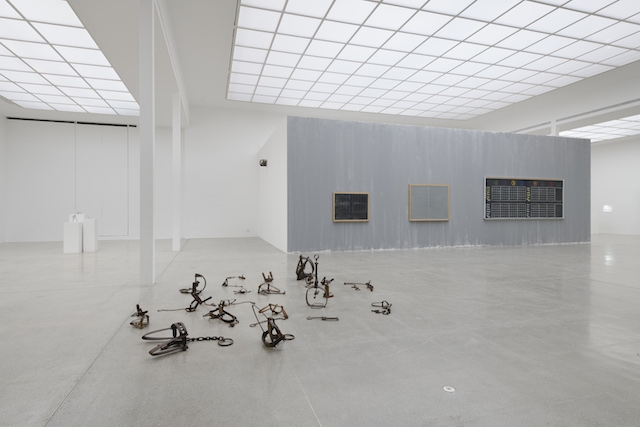In his catalogue essay, curator Anthony Huberman explains that the works in this exhibition ‘reflect on what it could mean to contest the regime of the machine’. That is, they question the worship of usefulness in modern scientific civilisation, which is refused or even ridiculed by each piece on show. It’s a strong concept, and potentially extends to how the works are placed in the labyrinthine space of the Secession. If the point is to produce friction, then the disorganisation of Other Mechanisms – the inability of its parts to add up to a coherent whole – is a paradoxical form of success.
Huberman’s text suggests he thinks of each work as a ‘machine’ in the expanded sense described by Gilles Deleuze and Félix Guattari – not just tools to realise a purpose, but a social ensemble comprising its makers and user. The wall texts describe each work clearly, and Huberman’s catalogue contains some inspired choices for philosophical passages to go with them (including examples by Jacques Ellul, Maurizio Lazzarato, Meredith Meredith and Lewis Mumford). These extracts further illuminate some already compelling individual works and let the viewer make visual and thematic connections thwarted in the exhibition’s organisation. A ‘complete’ viewing experience of an exhibition is barely possible, and catalogues shouldn’t try to achieve it, but rarely are they as vitally appropriate as this one.
The rusted antique animal traps making up Danh Vo’s Twenty-Two Traps (2012) are machines for maiming living things – for pest control or food – but they could just as easily be instruments of torture. Though they now appear pockmarked with age, the metal gnarled and corroded, their implied threat is not lessened since they are placed directly on the floor and set up with the potential to snap at our heels. Similar violent yearnings appear in a different context in Harun Farocki’s Serious Games III: Immersion (2009). This two-channel video shows how the virtual reality software used to train soldiers before they go to war is recycled as part of therapy for their damaged psyches once they return home suffering from post-traumatic stress disorder. Vo’s traps once met the basic need for human survival, but Farocki’s video suggests that soldiers are integrated into a closed system that meets two needs at once: training people for destruction and rebuilding them when they’re broken.
Zarouhie Abdalian’s, Joint (ii) and Nairy Baghramian’s Scruff of the Neck (UL 11, F) (both 2016) have the sharp and clinical look of medical equipment, but in each case their intertwining shapes make them more like fantasies of impracticality. Abdalian assembles small, interconnected heaps of mirrored, nickel-plated hand tools, placing them on plinths. They are arranged so delicately that they sometimes collapse under pressure, in stark contrast to the exaggerated scale of Baghramian’s twisting polished aluminium sculptures. Hanging on the wall, these drooping structures – like confused forms from dental-phobic nightmares – are the first pieces you see when entering the main exhibition space. The ridiculous white tooth at the base, complete with yellow plaque spot, nevertheless gives them a comic edge.
Placed on the museum’s moveable wall-dividers in the main space, Lutz Bacher’s Untitled (Chalk Board) and Chalkboard (Space) (both 2015) are chalkboards marked with routines, calendars and to-do lists. They aren’t just relics nostalgic for ways of organising ourselves before computerisation, such as dusty, iPad-free classrooms or hectic stock exchanges. Rather, they remind us that bureaucratic rationality is a machine for the administration of lives and bodies. This demands not only that we have the personal discipline to turn ourselves into willing slaves of a system in which we are disposable, but that ascetic self-denial – refusing anything that distracts from labour and profit-turning – is performed for its own sake.
If Other Mechanisms makes an argument, it’s that some things have intrinsic value, transcending and even forestalling human resource and data management. The exhibition thus interferes with the deliriously optimistic history of the future as Silicon Valley is writing it, reinforcing a healthy scepticism about the myth of technologically guaranteed progress, giving us the conceptual resources to separate technical from general human advancement and criticising the idea that technical ‘optimisation’ is an end in itself. Though it stops short of offering a compelling new narrative, it is nevertheless a valuable intimation of a conflict yet to come.
Other Mechanisms at Secession, Vienna, 29 June – 2 September
From the September 2018 issue of ArtReview
